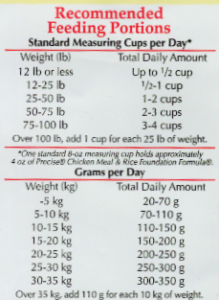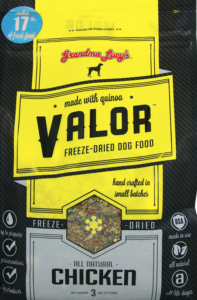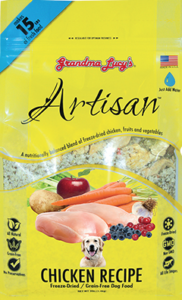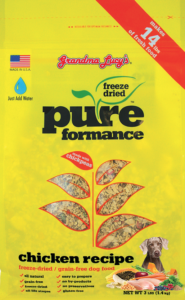
There’s no question that the “cheapest” way to feed a dog used to be with dry dog food, a/k/a kibble. Canned, dehydrated, freeze-dried or raw foods are typically more expensive, although that gap is slowly closing.
Your kibble cost will decrease a bit when replacing a portion of daily meals with any of these other forms of food. Whether your overall cost remains the same or increases depends on the amount and type of food used for the replacement.
Figuring out your combined cost is fairly simple when mixing canned or raw foods with kibble. But calculating the cost to add one of the growing numbers of dehydrated or freeze-dried (FD) mixes can be a bit more challenging. Some manufacturers make it simple, while others are less than forthcoming. Here’s how to protect your pocketbook in either situation.
All foods display Feeding Guidelines on their packages

These guidelines are the manufacturer’s recommendation for how much food an “average’ dog should eat to receive the minimum daily recommended amount of nutrition. The Feeding Guidelines are a good place to start, but will often be adjusted up or down, since your dog is not “average.”
Feeding Guidelines on kibble, cans and raw food are simple to follow. Kibble guidelines are shown in cups or ounces, canned food is shown in percentage of cans or ounces, and raw food is reflected by weight or individual portion pieces.
When it comes to FD or dehydrated mixes, you may be faced with a maddening combination of factors. Most mixes will boast how many pounds of fresh food their package rehydrates to make. Nice to know, but pretty useless as a feeding guide.
All mixes give you the amount of dry food and water to use for a particular size of dog. This is a good first step but does not help to determine your actual feeding cost.
You also want to know how much mix is contained in your particular package
Once you know both numbers- how much to use, and how much is in the package- you’ll be able to determine how long a package lasts. That allows you to calculate your cost to feed.
Don’t make the mistake of assuming that a 10 pound box of FD or dehydrated mix contains 20 cups of food. Yes, one cup contains 8 ounces (volume) and 16 ounces (weight) equals 1 pound. But one ounce of weight and one ounce of volume are different and not interchangeable.
Another way you can determine your feeding cost is to calculate calories
Most kibble packages will reveal how many calories are contained in a cup of food. If you reduce your kibble amount by 25%, you’ll look to replace 25% of the calories with your FD or dehydrated mix.

Calculating calories is slightly more complicated than starting with Feeding Guidelines, but results in a more exact method. The key to calculating calories or finding how many cups your package contains may require a phone call to the manufacturer. If the information is not clearly detailed on the package, that phone call is your best option.
Keep in mind that different formulas can have different guidelines
It makes sense that a higher protein and/ or fat formula would have lower feeding guidelines than one containing more grains, produce or less meat. This is why different formulas from the same manufacturer may reflect different feeding guidelines. That difference is also reflected in the number of calories per serving.
Let’s pick on one popular company and look at some examples from Grandma Lucy’s Chicken offerings.
Grandma Lucy’s offers 3 different Chicken-based freeze-dried mixes— Artisan, Pureformance and Valor. Each is grain-free and each has a different protein and fat content. Each has a different calorie content as reflected below:
Artisan Chicken: 26% Protein, 13% Fat, 439 calories/ cup
Pureformance Chicken: 34% Protein, 14% Fat, 492 calories/ cup
Valor Chicken: 30% Protein, 16% Fat, 554 calories/ cup

The Feeding Guidelines for each of these formulas is different along with the calorie count
For the “average” 50 lb dog, Artisan recommends 2 2/3 cups, Pureformace suggests 2 1/4 cups and Valor shows 2 cups are needed.
Does this mean a bag of Artisan will be used faster than a bag of Pureformance? That’s a reasonable assumption given the dry feeding guidelines. A quick call to the manufacturer reveals something else. There are 32 cups of food in the 8 lb bag of Artisan and 28 cups in the 8 lb bag of Pureformance.
This means that for the “average” dog following suggested Feeding Guidelines, each bag will last about 12 days. The Pureformance will offer almost a half day’s more meals because of the lower Feeding Guidelines.
How do we come to this conclusion? With the information missing from the bag but provided by the manufacturer it’s simple:
Artisan- 32 cups/ bag
• Artisan Feeding Guidelines- 2 2/3 cups/ day
• 32 cups/ 2.667 cups = 12 days (# cups/ bag divided by # cups fed/ day)

It’s actually 11.9985 days but let’s not get too technical. Your dog won’t mind the extra.
Pureformance- 28 cups/ bag
• Pureformance Feeding Guidelines- 2 1/4 cups/ day
• 28 cups/ 2.25 cups= 12.4 days (# cups/ bag divided by # cups fed/ day)
Okay, so it’s just under an extra half day of food. Your dog may bring this to your attention.
The calculation is simple with proper information
Keep in mind that all of the above math shows your cost and how long a bag lasts when exclusively feeding that particular food. If you’re mixing it with kibble, simply use a percentage of that amount to add to whatever portion of kibble you’ve chosen to replace.
As nice as it is to know how much fresh food a bag of mix makes, it is far more useful to know how that affects your wallet. Using the steps above will answer that question for you with a minimum of confusion.
Is mixing dehydrated/ FD foods with kibble is safe or advisable?
Like many decisions about pet food, whether to mix different forms of food in a single meal is a matter of personal preference. A case can be made for either approach.
Some say because different forms of food are digested at different rates, they should not be mixed. That position claims mixing different forms of food can stress the system and may even lead to bloat.

Others say it makes no difference since digestion regularly proceeds at different rates for different types of foods.
If you’re conflicted about this, yet another school of thought suggests feeding one form in the morning and another in the evening. This may be challenging when replacing a percentage of kibble with dehydrated or FD food since your dog may look forlornly for the missing kibble.
Our biased opinion is firmly non-committal. I’ve always mixed food forms and have had no issues other than my dog wanting more. I really don’t believe it makes much of a difference and have seen no evidence to support separating forms. You should do what makes the most sense to you.
Whichever way you choose to feed, adding some well balanced fresh food to your dog’s daily diet will be almost always be welcomed and met with tail wagging enthusiasm!

Leave a Reply